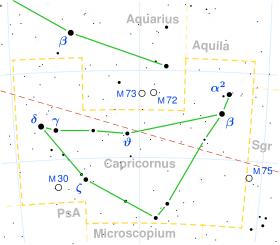Alpha Capricornids
Alpha Capricornids is a meteor shower that takes place as early as 15 July and continues until around 10 August.[1] The meteor shower was discovered by Hungarian astronomer Miklos von Konkoly-Thege in 1871. This shower has infrequent but relatively bright meteors, with some fireballs. Parent body is comet 169P/NEAT.
| Alpha Capricornids | |
|---|---|
 Celestial map of Capricornus | |
| Discovery date | 1871 |
| Parent body | 169P/NEAT (Minor planet 2002 EX12) |
| Radiant | |
| Constellation | Capricornus |
| Right ascension | 20h 44m 00s |
| Declination | −10° 00′ 00″ |
| Properties | |
| Occurs during | 15 July to 10 August |
| Date of peak | 29 July |
| Velocity | 23 km/s km/s |
| Zenithal hourly rate | 5 |
Peter Jenniskens and Jeremie Vaubaillon identified the parent body as asteroid 2002 EX12, which in the return of 2005 was found weakly active near perihelion.[2] This object is now called comet 169P/NEAT.
According to Jenniskens and Vaubaillon, the meteor shower was created about 3,500 to 5,000 years ago, when about half of the parent body disintegrated and fell into dust.[2] The dust cloud evolved into Earth's orbit recently, causing a shower with peak rates of 2-5/h, sometimes having outbursts of bright flaring meteors with rates up to 5-9/h.
The bulk of the dust will not be in Earth's path until the 24th century. The Alpha Capricornids are expected to become a major annual storm in 2220–2420 A.D., one that will be "stronger than any current annual shower."[2]
Notes
- "Alpha Capricornids: Encyclopedia Article". Encarta.msn.com. Encarta. Archived from the original on 19 April 2009. Retrieved 8 July 2014.
- "Minor planet 2002 EX12 ( = 169P/NEAT) and the Alpha Capricornid shower". Astronomical Journal. Retrieved 8 July 2014.
Minor planet 2002 EX12 ... is identified as the parent body of the alpha Capricornid shower, based on a good agreement in the calculated and observed direction and speed of the approaching meteoroids for ejecta 4500-5000 years ago....The bulk of this matter still passes inside Earth's orbit, but will cross Earth's orbit 300 years from now. As a result, the alpha Capricornids are expected to become a major annual shower in 2220-2420 A.D., stronger than any current annual shower